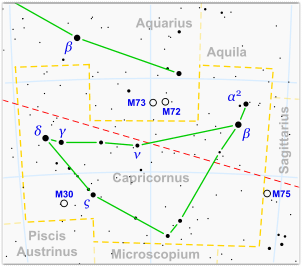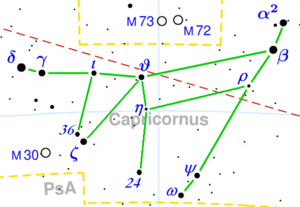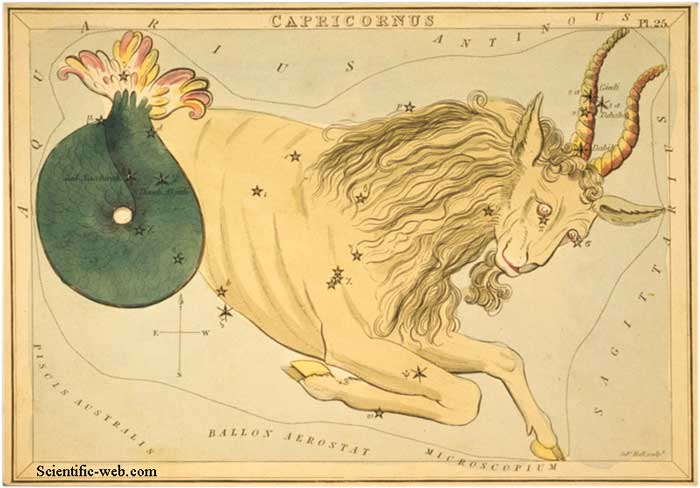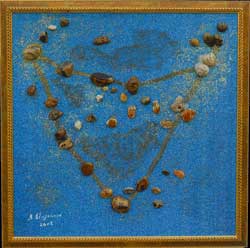
|
Capricornus ( Latin for "horned (male) goat" or "goat horn") is one of the constellations of the zodiac. It is commonly called Capricorn, especially when referring to the corresponding astrological sign (symbol or , Unicode ♑). It is also called the sea-goat, as it is in an area of the sky known as the Sea. Capricornus is one of the 88 modern constellations, and was also one of the 48 constellations listed by Ptolemy. Under its modern boundaries it is bordered by Aquila, Sagittarius, Microscopium, Piscis Austrinus and Aquarius. Notable features This constellation is the dimmest in the zodiac besides Cancer. Its brighter stars are found on a triangle whose vertices are α2 Capricorni (Giedi), δ Capricorni (Deneb Algiedi), and ω Capricorni. Notable deep sky objects Capricorn has several galaxies and clusters. Messier 30 is a globular cluster located 1 degree south of the galaxy group, NGC 7103. The constellation also harbors the wide spiral galaxy of NGC 6907. Named Stars History This constellation is one of the oldest to have been identified, possibly the oldest, despite its dimness. Since it falls in an area of the sky known as the sea, it became considered a sea-goat (in the same sense as a sea-maiden). Depictions of a goat or goat-fish have been found on Babylonian tablets dating back three thousand years. The constellation may owe its antiquity to the fact that at that time, the northern hemisphere's Winter Solstice occurred while the sun was in Capricorn. The concern for the sun's rebirth might have rendered astronomical and astrological observation of this region of space very important. For the same reason, the sun's most southerly position, which is attained at the northern hemisphere's winter solstice, is now called the Tropic of Capricorn, a term which also applies to the line on earth where the sun is directly overhead at noon on that solstice. Due to early Greek beliefs that sin accumulated throughout the year, causing the darkness to increase, together with the sun's descent and pause at the Solstice, the ancient Greeks referred to this area of sky as the Augean Stable, where they considered the sun stabled during the year. The cause of the association with the location or name of Augeas is not currently known. Perhaps an association could be made with the Labours of Hercules (or Heracles) who had to clean out the Augean Stables which had never been cleaned out before. The gradually accumulated dung could be synonymous with the gradually accumulated sins. However, during the classical period of Greek history, this name gradually fell out of use. Due to the precession of the equinoxes, the December solstice no longer takes place while the sun is in Capricorn, but the astrological period called Capricorn begins at approximately the same time as the solstice. The planet Neptune was discovered in this constellation by German astronomer Johann Galle, near Deneb Algedi (δ Capricorni) on September 23, 1846, which is reasonable as Capricornus can be seen best at 4:00am in September. Mythology This constellation is sometimes identified as Amalthea, the goat that suckled(breast fed) the infant Zeus after his mother Rhea saved him from being devoured by his father Cronos in Greek mythology. The goat's broken horn was transformed into the cornucopia or horn of plenty. Some ancient sources claim that this derives from the sun "taking nourishment" while in the constellation, in preparation for its climb back northward. However, the constellation is often depicted as a sea-goat, a goat with a fish's tail. One myth that deals with this says that when the goat-god Pan was attacked by the monster Typhon, he dove into the Nile; the parts above the water remained a goat, but those under the water transformed into a fish. In Sumer, the constellation was associated with the god Enki (Babylonian Ea), who brought culture out of the sea to humankind. The Greeks regarded the constellation area with an alternative interpretation, namely the Augean Stable – a stable full uncleanliness – representing the concept of sin accumulated during the year. The constellation of Aquarius, who was said to have poured out a river, then represent the yearly cleaning rains, associating to one of The Twelve Labours of Hercules. The constellation is located in an area of sky called the Sea or Water, consisting of many watery constellations such as Aquarius, Pisces, and Eridanus. Astrology The Western astrological sign Capricorn of the tropical zodiac (December 22–January 19) differs from the astronomical constellation and the Hindu astrological sign of the sidereal zodiac (January 19–February 15). Graphic visualization
Diagram of an alternative way to connect the stars of the Capricornus constellation.
The stars of the constellation Capricorn can be connected in an alternative way, which graphically shows a goat.[1] The goat's head is formed by the triangle of stars ι Cap, θ Cap, and ζ Cap. The goat's horn sticks out with stars γ Cap and δ Cap. Star δ Cap, at the tip of the horn, is of the third magnitude. The goat's tail consists of stars β Cap and α2 Cap: star β Cap being of the third magnitude. The goat's hind foot consists of stars ψ Cap and ω Cap. Both of these stars are of the fourth magnitude. Other interpretations have been offered, notably Ptolemy's.
Citations 1. ^ Rey, H. A. (1997). The Stars — A New Way To See Them, Enlarged World-Wide Edition, Boston: Houghton Mifflin. ISBN 0-395-24830-2. References * Ian Ridpath and Wil Tirion (2007). Stars and Planets Guide See also IC 1337 Links
Retrieved from "http://en.wikipedia.org/"
|
|
||||||||||||||||||||||||||||||||||||||||||||||||||||



